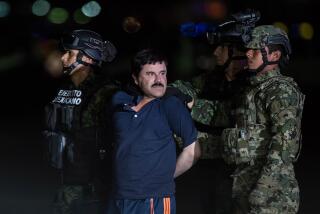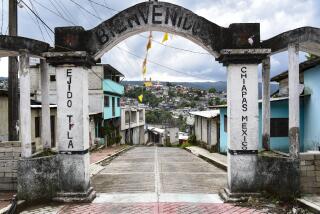Under Pressure From Honduras, Contras Move Their Border Operations
- Share via
LOS LAURELES, Honduras — In response to pressure from the Honduran government, Nicaraguan rebel forces have opened a new supply base in a remote area of Olancho province and are scaling back operations in an area known as the Las Vegas salient, where Sandinista troops attacked them last year.
The contras have also been shopping for farms in Olancho province, where their families could live and support themselves out of public view. Hundreds of contra families have already left their villages in the Las Vegas salient.
This activity reflects an effort by the Honduran government to regain control of the salient, the rugged area that juts south into Nicaragua about 80 miles east of Tegucigalpa, the Honduran capital. In recent months, the Honduran military has increased its presence in the salient. Officials are urging Honduran farmers to return to the land they abandoned there.
“This used to be a contra corridor, but not any more,” an army lieutenant said the other day, pointing to the dirt road into the salient. “The farmers stopped producing in this zone because of the conflict with the contras. The government and the armed forces decided this problem had to be resolved.”
Until a few months ago, the Honduran government had all but conceded the region to the contras. The area had become known as “New Nicaragua” and “Little Managua.” Cross-border skirmishes between Sandinistas and contras often erupted in the region, and thousands of Honduran peasants had fled to other areas.
In December, the situation worsened. Sandinista troops attacked the contras near their base camps at Yamales. U.S. Army helicopters ferried Honduran troops to the border, and the Honduran air force bombed Sandinista bases in northern Nicaragua.
Since then, Honduran President Jose Azcona Hoyo has been under intense political pressure to regain control of the territory, and the government has pressured the contras to move out.
With the arrival of new U.S. aid in recent months, thousands of re-equipped contras have left their camps near Capire in the salient to infiltrate into Nicaragua. According to sources close to the rebels, Sandinista forces launched a mortar attack on the contras’ training center near their strategic headquarters at Yamales last month, but only one contra guard was killed because the center had been virtually abandoned.
Contras are now being trained elsewhere, hundreds of them in the United States. Paratroop commandos have been trained at Aguacate, a Honduran base in Olancho province that has long been used by the contras for air supply missions.
Some contras are being trained in the Swan Islands in the Caribbean. One of the islands also serves as the principal depot for a CIA-run resupply operation and, according to rebel sources and others, as the base for “special operations commandos”--demolition teams that are parachuted into Nicaragua.
The rebels and their U.S. advisers, these sources said, hope eventually to move all supply operations to the Swan Islands site.
Access to Aguacate is restricted, but many reporters and photographers have managed to make their way into the area. They have avoided Honduran army roadblocks around Yamales by walking or riding horseback into the area.
The contras who remain in Honduras, estimated to number between 2,000 and 4,000, are divided between Yamales and the new supply base at San Andres de Bocay, about 60 miles northeast of Yamales in an area of Olancho province not served by any road.
“The advantage to San Andres is that it is less visible,” said a contra commander who goes by the nom de guerre Dimas.
Another source put it this way: “It’s easier to control access because it’s much farther away. Out of sight, out of mind.”
Some observers close to the situation say that Yamales may be abandoned altogether in the next couple of months. The contras have moved their strategic headquarters on at least one other occasion.
Locating the logistical base at San Andres de Bocay has clear advantages for the contras. It is closer to the border than Yamales, and it is near the mouth of the Bocay River, which flows south into Nicaragua. This makes it relatively easy to infiltrate troops and supplies across the frontier and to bring out wounded.
Farmers in southern Olancho province say they have seen as many as three helicopters a day on the way to and from the new base.
The contras have built an airstrip and a small airstrip at the base and are now building a warehouse.
San Andres is closer to the air base at Aguacate than is Yamales. From Aguacate, the severely wounded can be airlifted to a hospital. One of the contras’ biggest problems has been evacuating their wounded.
Bosco Matamoros, a spokesman for the Nicaraguan Democratic Force, the principal contra group, said that there are now three wounded contra commanders in Nicaragua. The man who calls himself Dimas was shot two months ago, in the leg, and walked for three days to get out of Nicaragua.
“We have lost a lot of men because of our inability to get them to a secure zone,” Matamoros said.
The contras have sent men into Jinotega province, in northern Nicaragua, in an effort to set up a forward operating base. There they could land helicopters, taking in supplies and bringing out wounded. But the Nicaraguan defense minister, Gen. Humberto Ortega, has announced a large-scale operation aimed at driving the rebels out of the area.
Plans May Change
If the Sandinistas succeed in routing the rebels from the Jinotega area, the contras will try to establish a base somewhere else in Nicaragua, rebel sources said.
“These plans are not laid in concrete,” one source said. “If the Sandinistas mass troops in one area, the Nicaraguan Democratic Force would be crazy to stay there and fight. They can move to another area.”
Honduran officials and the contras’ U.S. advisers hope that by reducing operations at Yamales and moving the contra dependents out of the Las Vegas salient, the contras who have moved into Nicaragua will be discouraged from returning to the salient.
People in El Paraiso province say that the contras are pulling out. The supply trucks that used to be seen in sizable numbers along the border road are unusual now, they say, and armed contras are rarely seen in the town of Las Trojes.
Reina Flores, a former refugee worker who lives in Las Trojes, said that dozens of families have moved back to towns such as Arenales, in the southern tip of the salient. She said the U.S. Agency for International Development has started public works projects there in an effort to draw the farmers back.
1,200 Evacuated
According to Honduran officials, nearly 1,200 Nicaraguans have been evacuated from the salient since December and taken to the overcrowded refugee camps at Danli, between the salient and Tegucigalpa. Others, they say, have left the salient on their own.
Contra plans to buy land in Olancho province are said to be running up against opposition. Many farmers in southern Olancho province were displaced by the contras in the Las Vegas salient.
Contra officials deny that they have any intention of buying land, but farmers here in Los Laureles say that contra officials have visited the village at least three times to look at land. The village is about an hour’s hike from the nearest road.
Among the people who are most opposed to the contras moving in are Israel Hernandez, 32, and his wife, Emma, 43. They are farmers who fled the salient last year after a Sandinista incursion.
“We left our property to ruin because of these people,” Hernandez said.
His wife said that if the contras move to Los Laureles, “we’ll keep on walking.”
“What are we going to do?” she went on. “Where the contras are, the other side follows.”
Francisco Beltran, the vice mayor of Los Laureles, added: “We don’t want these forces to come here. What happened to those people on their land could happen to us, here, tomorrow.”
More to Read
Sign up for Essential California
The most important California stories and recommendations in your inbox every morning.
You may occasionally receive promotional content from the Los Angeles Times.










